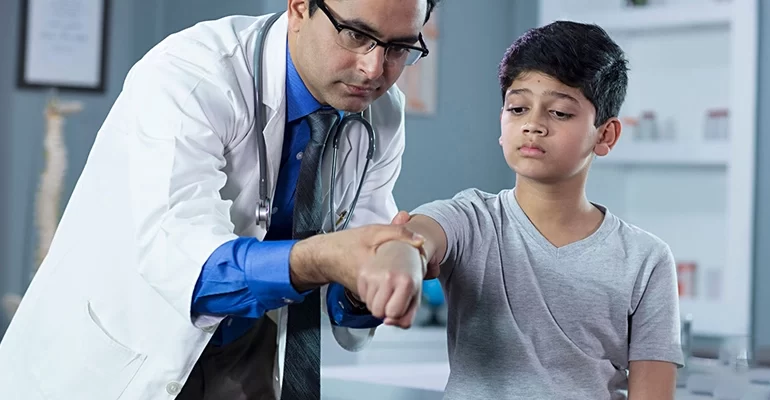Bone Test
- Serum Calcium
- Alkaline Phosphatase
- Phosphate
- Albumin Level
- Uric Acid
- Vitamin D
- RA Factor
- CRP (Quantitative)
- Anti-CCP
- Improving patient care by providing better imaging and diagnosis using advanced technology.
Frequently Asked Questions (FAQ's)
What is a bone density scan?
An examination that evaluates the quantity of calcium and other minerals in your bones when taking low-dose x-ray technology is called a bone density scan, or DEXA scan. Your bones’ bulk and strength, also referred to as their bone density, are depicted by this measurement.
The majority of people’s bones weaken with age. Osteopenia is the term for when bones thin more than usual. Osteoporosis is a more dangerous disorder that can happen to people who have osteopenia. The degenerative illness known as osteoporosis results in extremely thin and fragile bones. Osteoporosis is most common in women over 65 and often affects elderly adults. Fractures, or shattered bones, are more common in people with osteoporosis, particularly in the hips, spine, and wrists.
Additional names for this test include dual-energy x-ray absorptiometry (DXA); bone mineral density test; BMD test; DEXA scan; and DXA.
What is it used for?
Identify osteopenia (poor bone mass) using a bone density scan
Determine the osteoporosis
Forecast the chance of more fractures
Assess the efficacy of osteoporosis treatment.
Why do I need a bone density scan?
Any woman who is 65 years of age or older than should get a bone density scan. This age group of women is particularly vulnerable to bone density loss, which can result in fractures. Low bone density may also be a concern for you if you:
possess an extremely little body mass
suffered at least one fracture after turning fifty.
have experienced a height loss of at least half an inch in a year
Are you a man older than seventy?
have a history of osteoporosis in your family
Additional risk variables consist of:
Absence of exercise
puffing on cigarettes
binge drinking
Inadequate consumption of calcium and vitamin D
What happens during a bone density scan?
Bone density can be determined in a variety of methods. Dual-energy x-ray absorptiometry, or DEXA scan, is the commonly used and most accurate method. In a radiologist’s office, the scan is typically performed.
During a DEXA scan:
Reclining on a cushioned table is what you will do. Pretty sure you can wear what you’re wearing.
The instructions may be to rest your legs on a padded platform or to lie with your legs straight.
Your hips and lower back will be scanned by a device. You will be moving beneath a photon generator, which is another scanning device, at the same time. An image fusion and computer transmission will occur between the two machines. On the computer screen, a medical professional will see the images.
It is necessary that you remain motionless during the scanning process. Holding your breath could be requested of you.
Providers may utilize a handheld scanner called a peripheral DEXA (p-DEXA) scan to detect bone density in the forearm, finger, hand, or foot.
Will I need to do anything to prepare for the test?
24 – 48 hours before your test, you might be instructed to cease taking calcium supplements. Additionally, you should refrain from wearing clothing with metal accents like buttons or buckles or jewelry made of metal.
Are there any risks to the test?
Radiation exposure during a bone density scan is quite low. Most people can safely use it. Pregnant women are advised against using it, though. Radiation can be harmful to a developing embryo even at modest concentrations. If you suspect you could be pregnant, make sure your provider knows.
What do the results mean?
A “T” score is commonly provided as a consequence of bone density testing. When your bone density is measured and compared to that of a healthy 30-year-old, the result is called a T score. There is likely some bone loss if your T score is low.
One of the following could be displayed in your results:
-1.0 or greater on the T scale. Bone density like this is regarded as typical.
between a -1.0 and -2.5 T score. You may be susceptible to developing osteoporosis as a result of your low bone density, or osteoopenia.
less than a -2.5 T-score. You most likely have osteoporosis as a result of this.
Should the findings indicate that you have low bone density, your physician will suggest actions to stop additional bone loss. They could consist of:
walking, dancing, and using weight machines as ways to increase your level of activity.
Include vitamin D and calcium in your daily diet
Using pharmaceuticals to improve bone density
See your healthcare practitioner if you have any queries regarding your results and/or bone loss therapies.
Get additional information on reference ranges, laboratory testing, and comprehending outcomes.
Is there anything else I need to know about a bone density scan?
Typically, bone density is determined via a DEXA scan. In order to verify a diagnosis or determine whether treatment for bone loss is effective, your healthcare professional could, however, request additional testing. Some examples of these include blood testing for hormones, vitamin D, and/or calcium.

